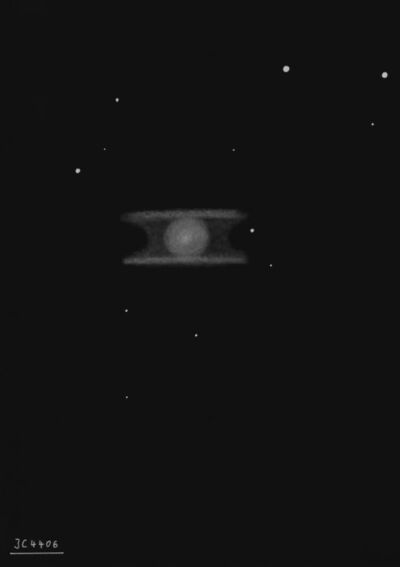
Williamina Fleming discovered IC 4406 = D.S. 403 = Fleming 94 in 1901 on a Harvard objective prism plate from Arequipa (1901HarCi..60....1P). DeLisle Stewart also found this planetary on a plate taken in 1899 at Harvard's Arequipa Station, though published in 1908. He noted "2 nebulous stars make dumb-bell, remarkable." Finally, Robert Innes independently found it a third time while observing with the 7-inch Metz refractor of the Royal Observatory at the Cape of Good Hope. He wrote, "As seen with the 7-inch on 14 August 1901 this is a fine planetary nebula, 10th magnitude, about 20" in diameter. Examined on the same night with the 18-inch telescope, it appears dumb-bell-shaped..." Perhaps surprisingly, John Herschel missed this fairly bright planetary.
300/350mm - 13.1" (2/20/04 - Costa Rica): at 140x this bright bipolar planetary appeared fairly small, 20"-25" diameter with a high surface brightness and a bluish color. The outline is unusual, appearing somewhat boxy or rectangular in appearance. A faint star is just off the west edge. At 195x there appeared to be very faint extensions ~E-W, increasing the dimensions to 2:1.
13.1" (3/17/86): fairly bright and prominent with a Daystar 300 filter although viewed at a low elevation. Fairly small, 35" diameter, smooth disc. Visually appeared almost round although photos reveal a very elongated shape. No central star seen at 214x. A mag 13.5 star is just off the west edge.
13.1" (6/18/85): viewed for 1-2 minutes as it appeared and disappeared just east of Fremont Peak from Coulter Row. Appeared fairly bright and fairly small and roundish.
400/500mm - 18" (7/5/05 - Magellan Observatory, Australia): at 228x, this is a very striking planetary with an unusual appearance. The main body is bright and boxy, roughly 25" diameter with a bluish color. A number of mag 14 stars appear to huddle around the planetary including a mag 13.5 star at the west end and some additional mag 13 stars are within 2'. Much fainter extensions or wings are just visible extending E-W from the main body with the western wing slightly more prominent (though this may be due to the superimposed star). The wings are more obvious when a UHC filter is used. At 293x, there are three collinear stars just off the west edge with the western extension encompassing the closest star. The wings increase the overall dimensions to ~60"x25".
Notes by Steve Gottlieb